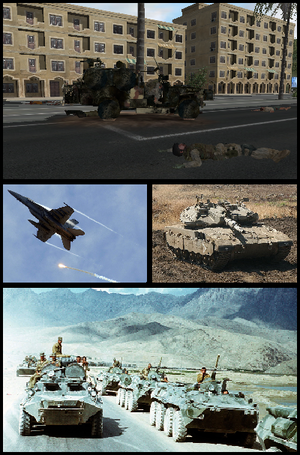Neo-Venetia War
| Neo-Venetia War | ||||||||
|---|---|---|---|---|---|---|---|---|
|
||||||||
| Belligerents | ||||||||
22px Soviet Union | Soviet Sindorin | 22px Social Republic of Neo-Venetia | ||||||
| Commanders and leaders | ||||||||
| 22px Gennady Zyuganov 22px Lt. General Georgi Pukhov |
| 22px Rolando di Ferroforte † 22px Francesco Mountz |
||||||
| Units involved | ||||||||
| Soviet forces: Belarian forces:
GRFOR Neo-Venetia:
| ||||||||
| Casualties and losses | ||||||||
| Military Dead: 6 | Military Dead: 23 | Military Dead: 0 |
||||||
The Neo-Venetia War was an armed conflict in Neo-Venetia between Angleter and an European Union Security Council-led coalition that lasted from 11 December 2008 until 21 April 2009. It began with the Angleteric invasion of Neo-Venetia on 11 December 2008, and ended with the celebration of legislative elections in Neo-Venetia on March-April 2009. Angleter sought principally to annex the totality of Neo-Venetian territory, obtaining its ports and access to the Persian Gulf, claiming security reasons, primarily the protection of Angleter and its population from a possible Animamortus outbreak. Angleter invaded the country and the EUSC reacted by sending armed peacekeeping forces.
Contents
Background
In early December 2008 a massive Animamortus virus outbreak occured around the European Union. Amidst fears of it reaching Angleter via Neo-Venetia, plans were drawn for a land occupation of the country. However, it has been said that it was a simple pretext to take over the country, which possessed the sea access Angleter wished to control. On December 5th, the head of the Angleteric navy expressed the country's need for a sea access.
Invasion
On December 11th by the late night, Angleteric military forces led by Major General Baron Curtis entered Neo-Venetia. The military action was quickly condemned by many EU member states including the Soviet Union and Belarum. At 6pm on that day, Angleteric Prime Minister declared the country officially annexed to the Grand Marquessate. Occupying troops were not welcomed and on the next day attacks were reported by independentist forces which resulted in the deaths of 54 civilians and 23 Angleteric soldiers.
To counter Angleteric military action, the Soviet Union announces the deployment of troops in Neo-Venetia to maintain peace and stability. It is soon followed by the Duxburian Union, which deployed troops alongside the border on December 14th, and Belarum which announced a troop deployment on December the 16th.
EUSC intervention
In the early days after the initial Angleteric invasion of the country, EUSC countries quickly mobilised by sending their troops to the occupied country with the Soviet Union and Belarum acting first.
Belarian ultimatum
On February the 20th, Belarian President Evan Burke delivered a speech on free television announcing a 72-hour ultimatum on Angleter to evacuate their troops from Neo-Venetia to restore its independence. After
Elections
Between March 25th and April 14th a general election took place in Neo-Venetia. It was contested by a handful of parties, the most important ones being the Coalition for the Unification of Neo-Venetia and Angleter (CUNVA), the Communist Party of Neo-Venetia (CPNV), the center-left Movement for the Popular Front (MPF), the Neo-Venetia Democratic Party (NVDP), and the Social Republicans. The elections were won by the MPF which achieved around 50% of the votes, followed by the CPNV with 25% and CUNVA which got the 19%.
Post war
After elections took place, however, Belarian and Grossdeutscher troops remained stationed at the country. For a long time has the Neo-Venetia War still remained an important topic in Angleteric politics, with irredentism on the gulf coast state being still publicly displayed by Angleteric politicians and parties. Numerous efforts were implemented coming from various sides to rebuild the war-torn country, including the approval of the Act to Organise non-EUSC Aid to Neo-Venetia by the European Council which led to the creation of the ENVACA (European Neo-Venetia Aid Co-Operative Agency), tasked with organising help to Neo-Venetia coming from non-EUSC countries.
Timeline
2008
- December 11th: Angleter announces the deployment of its troops to Neo-Venetia as a first step for annexation. Angleter invades Neo-Venetia.
- December 12th: The Soviet Union announces massive troop deployment to Neo Venetia to maintain peace. Angleter annexes Neo-Venetia.
- December 13th: Attacks reported on Angleteric troops resulting in the death of 77 people.
- December 14th: Duxburian Union forces are deployed at the border with Neo-Venetia.
- December 15th: Angleter enforces conscription on all men aged 27 to 29.
- December 16th: Belarum announces deployment of land, sea and air units to Neo-Venetia.
2009
- January 13th: USSR starts embargo on Neo-Venetia to contain Angleteric expansionism. Belarum joint soviet-enforced embargo. Soviet and Sindorinian troops mobilise at the USSR-Sindorinian border.
- January 16th: Grossdeutsches Reich deploys the Bismarck Batallion to Neo-Venetia to act as a beachhead for GRFOR Neo-Venetia.
- January 21st: Belarian troop deployment completed.
- January 22nd: 25,000 men-strong GRFOR Neo-Venetia fully deployed. Francesco di Ferroforte, leader of the Social Republicans, is assassinated.
- February 10th: 6 GRFOR troops killed in missile attack by insurgent elements.
- February 20th: Belarum issues a 72-hour ultimatum to Angleter demanding its full withdrawal from Neo-Venetia.
- February 21st: Grossdeutscher government announces troop number increase to 99,000 men.
- February 22nd: Tense Sunday. Tensions rise among belligerent powers as ultimatum deadline comes to a close. Angleter decides to withdraw its troops from Neo-Venetia.
- February 23rd: Belarian President Evan Burke announces success of 72-hour ultimatum.

